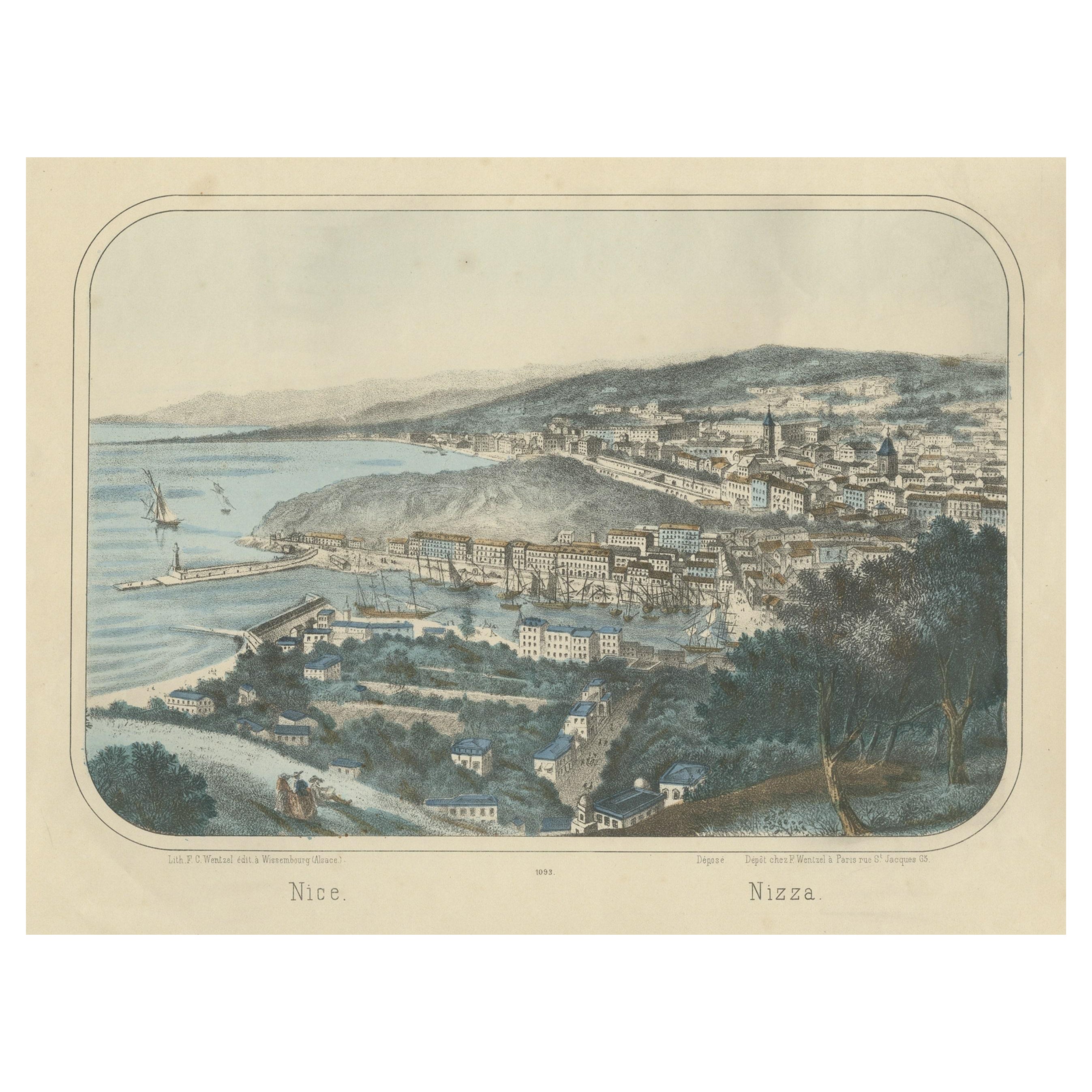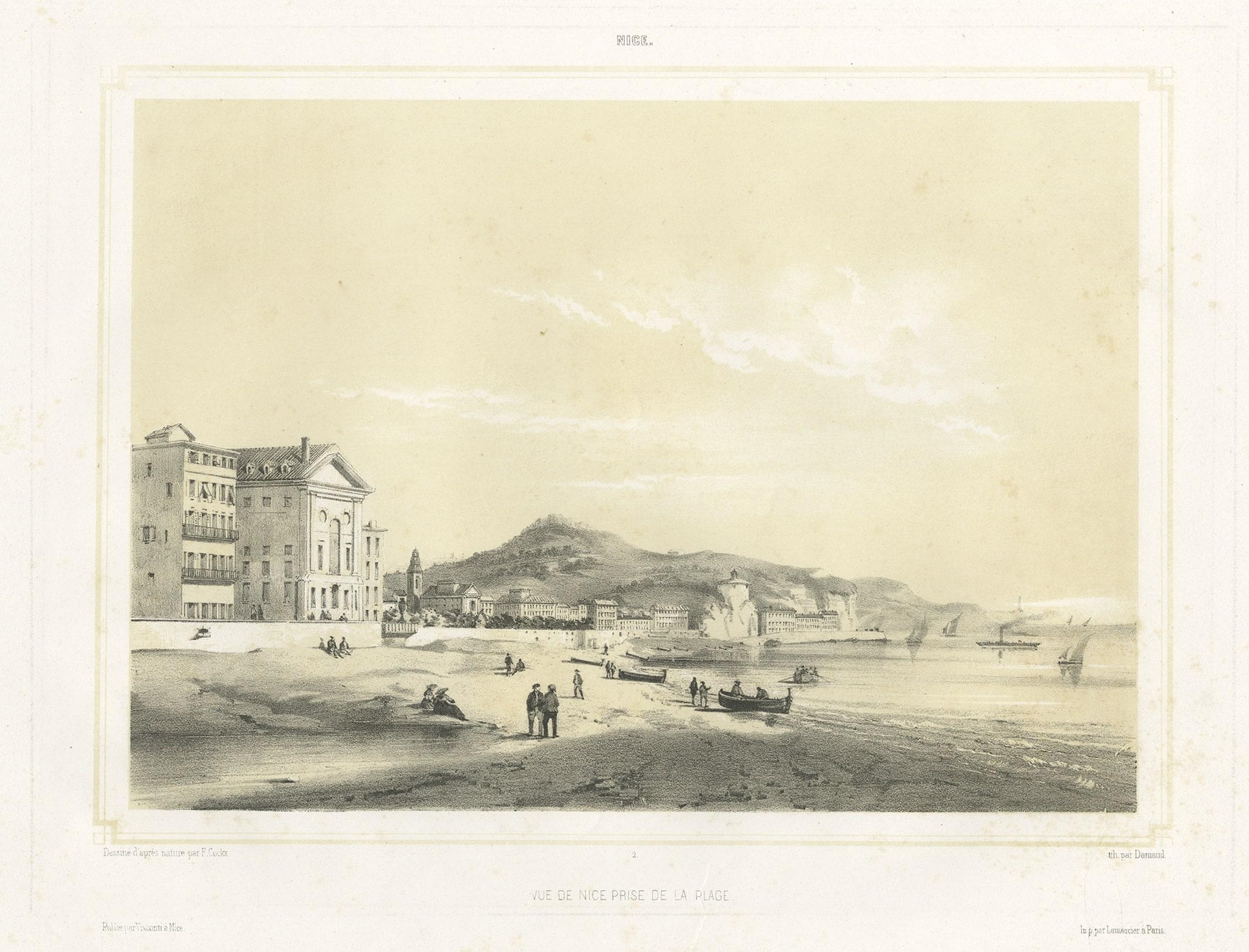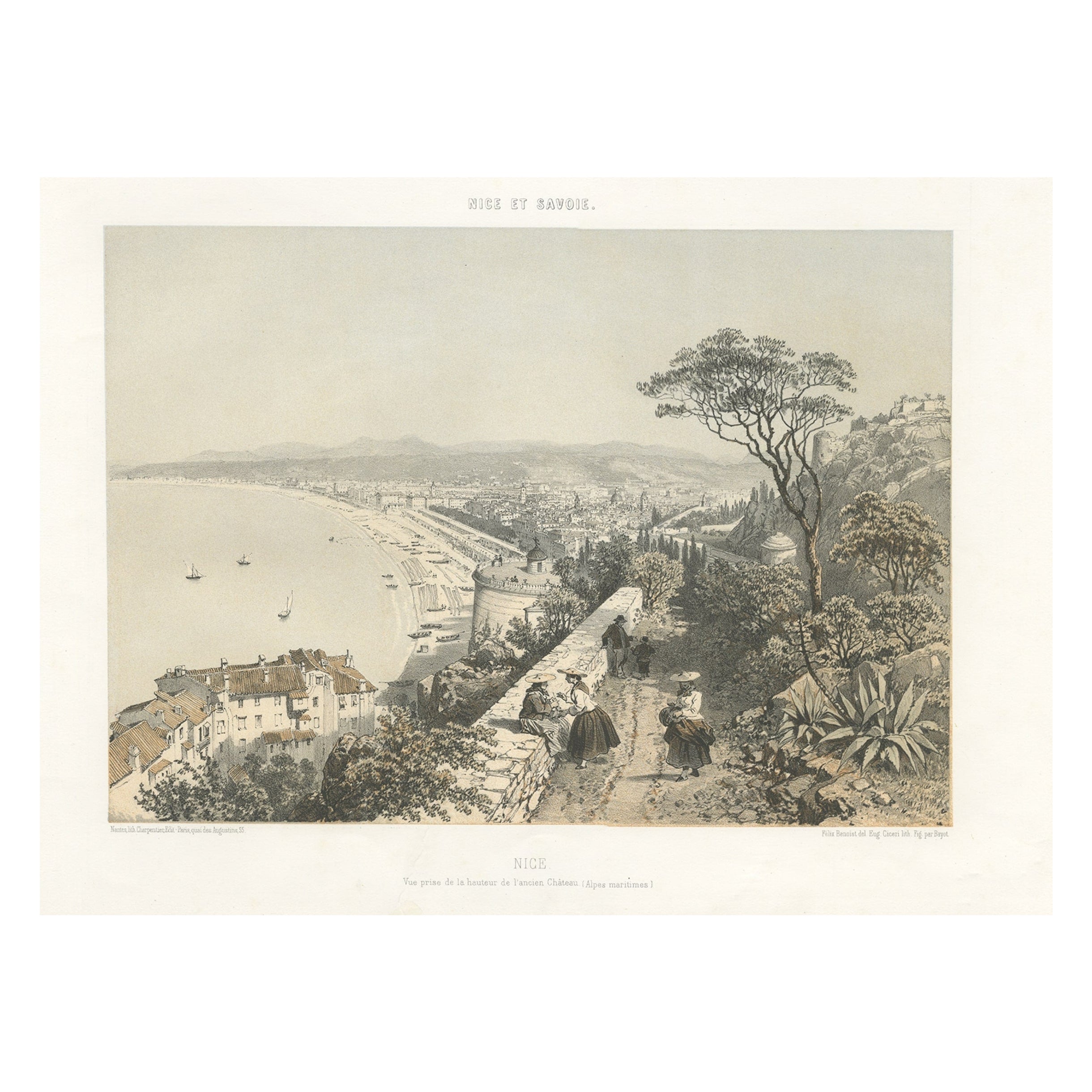Items Similar to Old City View of the City of Nice, France, in the 17th Century, 1855
Want more images or videos?
Request additional images or videos from the seller
1 of 6
Old City View of the City of Nice, France, in the 17th Century, 1855
About the Item
Antique print titled 'Nice au XVIIe Siecle d'apres une Gravure de l'Epoque'. Original antique print of the city of Nice, France. This print originates from the series 'Nice et ses environs', published 1855.
Artists and Engravers: Published by Lemercier. Lithographed by Daniaud after F. Cockx.
Condition: Fair, general age-related toning. Shows some wear and defects, mainly in margins. Blank verso, please study image carefully.
Date: 1855
Overall size: 39 x 27 cm.
Image size: 27 x 19 cm.
Antique prints have long been appreciated for both their aesthetic and investment value. They were the product of engraved, etched or lithographed plates. These plates were handmade out of wood or metal, which required an incredible level of skill, patience and craftsmanship. Whether you have a house with Victorian furniture or more contemporary decor an old engraving can enhance your living space.
- Dimensions:Height: 10.63 in (27 cm)Width: 15.36 in (39 cm)Depth: 0 in (0.01 mm)
- Materials and Techniques:
- Period:
- Date of Manufacture:1855
- Condition:Condition: Fair, general age-related toning. Shows some wear and defects, mainly in margins. Blank verso, please study image carefully.
- Seller Location:Langweer, NL
- Reference Number:
About the Seller
5.0
Platinum Seller
These expertly vetted sellers are 1stDibs' most experienced sellers and are rated highest by our customers.
Established in 2009
1stDibs seller since 2017
1,922 sales on 1stDibs
Typical response time: <1 hour
- ShippingRetrieving quote...Ships From: Langweer, Netherlands
- Return PolicyA return for this item may be initiated within 14 days of delivery.
More From This SellerView All
- Old Hand-Colored View of the City of Nice in Southern France, ca.1860Located in Langweer, NLDescription: Antique print titled 'Nice - Nizza'. View of the city of Nice, France. Source unknown, to be determined. Artists and Engravers: Published by F. Wentzel. Jean Fréd...Category
Antique 1860s Prints
MaterialsPaper
- Antique Print of the City of Nice from the Beach, France, 1855Located in Langweer, NLAntique print titled 'Vue de Nice prise de la Plage'. Original antique print of the city of Nice seen from the beach, France. This print originates from the series 'Nice et ses envir...Category
Antique 19th Century Prints
MaterialsPaper
- Antique View of the City of Nice on the South-Coast of France, c.1865Located in Langweer, NLAntique print titled 'Nice, vue prise de la hauteur de l'ancien Château'. Original antique print of the city of Nice, France. This print originates from 'Nice Et Savoie, Sites Pittor...Category
Antique 19th Century Prints
MaterialsPaper
- Antique Print of the City of Villefranche in Southern France, 1855Located in Langweer, NLAntique print titled 'Vue de Villefranche'. View of Villefranche near Nice, France. This print originates from 'Nice et ses environs', published 1855. This print originates from the ...Category
Antique 19th Century Prints
MaterialsPaper
- Nice Antique City View of the Lombard on The Oudezijds Voorburgwal in AmsterdamBy D. Olfert DapperLocated in Langweer, NLAntique print titled 'De Banck van Leeningh'. View of the City Bank of Loan in Amsterdam, the Netherlands. Also known as the Lombard, located on the Oudezijds Voorburgwal of Amsterda...Category
Antique 17th Century Prints
MaterialsPaper
- Antique Print of the City of Nice in France, c.1840Located in Langweer, NLAntique print titled 'Bei Nizza am Gulf Juan'. Original antique print with a view of Nice, France. This print originates from 'Aus dem König-Ludwigs-Album'. Published circa 1840. ...Category
Antique 19th Century Prints
MaterialsPaper
You May Also Like
- 17th Century Etchingn "Adoration of the Magi" by Pietro Testa, circa 1640By Pietro TestaLocated in Cagliari, ITBeautiful etching representing the classic religious subject of the "Adoration of the Magi" by the Baroque painter and engraver Pietro Testa known as il Lucchesino. The print derives from an oil on canvas of the same name now in Montpelier. Identified by the TPL monogram on the right and the dedication signature. Paolo Bellini in the book "L'opera incisa di Pietro Testa" (The engraving work of Pietro Testa) ,published in 1976 by Neri Pozza in Vicenza, identifies this work as an example of the third state of three since, respect to the second state, the address of Gio Giacomo Rossi is added . In the lower margin there is the dedication in Latin to: Most illustrious and most reverend (cardinal) Gerolamo Bonvisi, Cleric of the Apostolic Chamber, D.D. The star on the left often blushes with the light of evil / Kings live here so that they recognize the Lord, / happy face good star shines benignly./ Petrus Testa Pietro Testa (1611–1650) was an Italian High Baroque artist active in Rome. He is best known as a printmaker and draftsman. He was born in Lucca, and thus is sometimes called il Lucchesino. He moved to Rome early in life. One source states he was ejected from the Cortona studio in 1631, soon after joining the workshop. Others state Testa trained under Pietro Paolini or under Domenichino, for whom he worked under the patronage of Cassiano dal Pozzo. He was friends with Nicolas Poussin and Francesco Mola. Some of his etchings, which often include work in drypoint, have a fantastic quality reminiscent of Jacques Callot, or embellishments of his Genoese contemporary Giovanni Benedetto Castiglione and even presciently suggest William Blake. His Sacrifice of Iphigenia appears to have influenced Tiepolo's rendition at Villa Valmarana Ai Nani in Vicenza. His early prints, from the 1630s, were often religious and were influenced by Federico Barocci...Category
Antique 17th Century Italian Baroque Prints
MaterialsPaper
- 17th-Century Botanical Engravings of Mosses and Ferns By John ParkinsonBy John ParkinsonLocated in Downingtown, PAJohn Parkinson was the last of the great English herbalists and one of the first of the great English botanists. Here the pair of prints show mosses and lichen and the other of ferns. From: Paradisi in sole Paradisus Terrestris: or a garden of all sorts of pleasant flowers...Category
Antique 1620s English Jacobean Prints
MaterialsPaper
- 17th Century Pair of Burin Prints by Giovanni Battista Vanni, Italy, 1642By Antonio da Correggio, Giovanni Battista VanniLocated in Cagliari, ITA beautiful pair of burin engravings depicting "Saint Bernardo degli Uberti" and "Saint Hilary of Poitiers" two of the patron saints of the city included in the base of the cupola ( dome ) of Parma cathedral frescoed by Antonio Allegri known as Correggio (Correggio, August 1489-Correggio 5 March 1534) between 1524 and 1530. Admirable work by the great master in which his genius as a forerunner of the Baroque is fully seen. In 1642 Giovanni Battista Vanni etched a series of fifteen plates from Correggio's frescoes. Giovanni Battista Vanni was born in Pisa around 1599; he studied successively under Jacopo da Empoli, Aurelio Lomi, and Matteo Rosselli, and then became a disciple of Cristofano Allori. He is better known as an engraver than as a painter. From 1624 to 1632, he lived in Rome, then returning to Florence after visiting Venice. In addition to the series of prints...Category
Antique 17th Century Italian Baroque Prints
MaterialsPaper
- 17th Century Pair of Etchings by Theodoor Van Thunlden from Rubens, Antwerp 1642By Peter Paul Rubens, Theodoor van ThuldenLocated in Cagliari, IT"Arch dedicated to Hercules" and "Arch dedicated to Bellerophon" Splendid and very rare etchings belonging to a suite of subjects executed for the preparations of the "Celebrations for the entry into Antwerp of the Cardinal-Infante Ferdinando of Habsburg-Spain on 17 April 1635". The sketches for the decorations were all drawn by Sir Peter Paul Rubens and the execution of the etchings was entrusted to Van Thulden. Bottom left: P.P. Rubens. Bottom right: G. Gervatius (who was commissioned to bring together the illustrations of the arches in a special volume) and Van Thulden. Laid paper with watermark - copper imprint - margins - excellent condition. At the end of 1634 Peter Paul Rubens (1577-1640) was invited to make a series of drawings to decorate the city of Antwerp on the occasion of the solemn entry of the infant cardinal Ferdinand of Habsburg (1609-1641) who, after his death of Archduchess Isabella Clara Eugenia (1633), Spanish governor of the southern Netherlands, had been elected as his successor. Generally in these circumstances, the itinerary was articulated through a series of stations and the city - in its main urban hubs - was adorned with decorations and ephemeral apparatuses which, without solution of continuity, covered the facades of the palaces, churches and convents facing the parade axis of the celebratory itinerary, testifying to the participatory role of the various public and private institutions that took part in the feast1. As had happened for the entrances of Charles V in 1520, of Philip II in 1549 and of the archdukes Albert and Isabella in 1599, also in this case, on 17 April 1635, the most important streets and squares of Antwerp were enriched with arrangements: temporary altars, four scenarios, a portico and large triumphal arches built in wood, over twenty meters height, decorated with paintings, sculptures and allegorical scenes. The references to the ancient alluded in this case to the greatness of the Habsburgs and to the merits of Ferdinand for the victory obtained over the Protestant armies of Sweden and their German allies. The choice to use the triumphal arch has its roots in the "city of the popes" and must be read as a connection with the triumphal and modern arches, with Rome and with the "possession" ceremony, placing the emphasis on its centuries-old use . In the elaboration of the drawings and sketches Rubens proved to be a true connoisseur of architecture, but what is most surprising about the artist is the casual use of architectural language and fidelity to sixteenth-century Roman models. In order for the memory of these works to be perpetuated over time, some artists were commissioned to etch the ephemeral apparatuses and, under the guidance of the painter Theodor van Thulden...Category
Antique 17th Century Belgian Baroque Prints
MaterialsPaper
- 17th Century Pen and Ink Architectural Drawing Signed Bartolomeo PedrelliLocated in New York, NY17th Century Italian Architectural Drawing of a Palazzo which has been done with pen and ink with a grey wash. Signed on reverse by Bart...Category
Antique 17th Century Italian Neoclassical Decorative Art
MaterialsPaper
- Fine 17th Century Italian Etching by Salvator Rosa, 1615-1673By Salvator RosaLocated in Vero Beach, FLSalvator Rosa, the Italian Baroque painter was also a significant etcher and printmaker. Rosa’s is series of small prints of soldiers was very popular and influential. This etching i...Category
Antique 17th Century Italian Baroque Prints
MaterialsPaper
Recently Viewed
View AllMore Ways To Browse
17th Decor
Antique Gravure
French Glass Front Cabinet
Chinese Painted Wood Panel
Side Cabinet Blue
18th Century Styled Chests
Italian Commode Pair
Metal Platform
Vintage Pair Of Doors
Antique Italian Carved Walnut
Antique French Carved Wood Cabinet
Painted Commode Antique
Mahogany Three Drawer Chest
Victorian Slider
Victorian Slide
Antique Display Cupboard
Kitchen Units Vintage
Oak Glass Display





